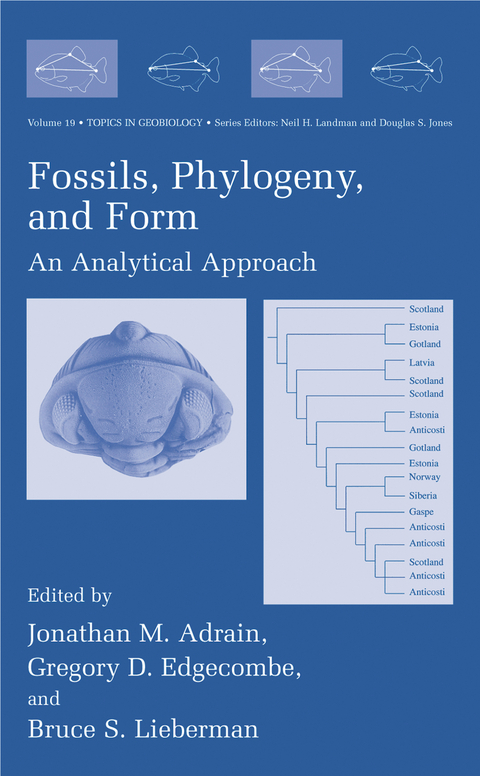
Fossils, Phylogeny, and Form
Springer-Verlag New York Inc.
978-1-4613-5137-5 (ISBN)
The fossil record is our one true chronicle of the history of life, preserving a set of macroevolutionary patterns; thus various hypotheses about evolutionary processes can be tested in the fossil record using phylogentic analysis and morphometrics.
The first book of its type, Fossils, Phylogeny, and Form will be useful in evolutionary biology, paleontology, systematics, evolutionary development, theoretical biology, biogeography, and zoology. It will also provide a practical, researcher-friendly gateway into computer-based phylogenetics and morphometrics.
1 • Paleobiology: An Empirical Historical Science.- A Historical Perspective.- Phylogeny and Form.- References.- 2 • Phylogenetic Systematics: Five Steps to Enlightenment.- The Terminology.- The Method.- Summary.- Acknowledgments.- References.- 3 • Morphometry and Phylogeny in the Resolution of Paleobiological Problems—Unlocking the Evolutionary Significance of an Assemblage of Silurian Trilobites.- Paleontology’s Contribution to Understanding Evolution.- Research Questions.- Locality.- Study Sample.- Analysis.- Discussion.- Summary.- Acknowledgments.- References.- 4 • Morphological Disparity: A Primer.- Cladistic Concepts.- Phenetic Concepts.- Phenetic Indices of Disparity.- Disparity and Major Body Plans.- Other Factors Variously Related to Disparity.- The Continuity of Morphospace Occupation.- Patterns of Disparity Through Time.- Morphological Constraints.- Disparity and Extant Biodiversity.- Conclusions.- Acknowledgments.- References.- 5 • Homology, Characters, and Morphometric Data.- Homology.- Homology and Classes of Morphometric Variables.- Conclusions.- Acknowledgments.- References.- 6 • Landmarks, Localization, and the Use of Morphometrics in Phylogenetic Analysis.- The Geometric Basis of Morphometric Observations.- The Biological Basis of Morphometric Observations.- Materials and Methods.- Results.- Discussion.- Summary.- Acknowledgments.- References.- 7 • Cladistic Biogeography: Component-Based Methods and Paleontological Application.- Geographic Congruence.- The Role of Fossils.- Optimality.- Area Definition.- Taxon-Area Cladograms, Areagrams and General Areagrams.- Analytical Problems and Assumptions.- Current Component-Based Approaches.- Sources of Ambiguity.- Node Interpretation.- Cladograms and Trees Revisited.- Acknowledgments.-Notes.- Glossary of Terms.- References.- 8 • Stratigraphy, Phylogeny, and Species Sampling in Time and Space.- Reconstructing Phylogeny With and Without Temporal “Data”.- Time as “Data”.- Utility of Strato-Phylogenies.- Strato-Methods and Sampling.- Trilobite Species Sampling in the Laurentian Sunwaptan.- Phylogeny of the Euptychaspidinae and Macronodinae.- Phylogeny Versus Sampling.- Conclusions.- Acknowledgments.- References.- Appendix 1. Character List for Analysis of Euptychaspidinae and Macronodinae.- 9 • Analyzing Speciation Rates in Macroevolutionary Studies.- The Rates of Evolution Most Relevant to Paleontological Studies of Macroevolution.- Approaches to Analyzing Rates of Speciation.- Conclusions.- Acknowledgments.- References.- 10 • The Nature and Origin of Supraspecific Taxa Revisited—With Special Reference to Trilobita.- The Sloshing Bucket.- Trilobites: How Do the Predictions of the Sloshing Bucket Fare?.- Acknowledgments.- Notes.- References.- 11 • The Role and Design of Databases in Paleontology.- Databases Today.- Kinds of Databases.- Security, Access, and the Value of Information.- The Electronic Relational Database.- Databases in Paleontology.- The Future of Databases in Paleontology.- Conclusions.- Acknowledgments.- References.
| Reihe/Serie | Topics in Geobiology ; 19 |
|---|---|
| Zusatzinfo | XIV, 402 p. |
| Verlagsort | New York, NY |
| Sprache | englisch |
| Maße | 178 x 254 mm |
| Themenwelt | Naturwissenschaften ► Biologie ► Evolution |
| Naturwissenschaften ► Biologie ► Zoologie | |
| Naturwissenschaften ► Geowissenschaften ► Mineralogie / Paläontologie | |
| ISBN-10 | 1-4613-5137-5 / 1461351375 |
| ISBN-13 | 978-1-4613-5137-5 / 9781461351375 |
| Zustand | Neuware |
| Haben Sie eine Frage zum Produkt? |
aus dem Bereich


